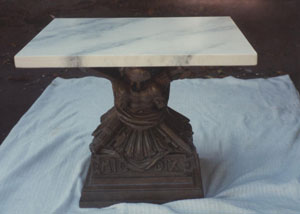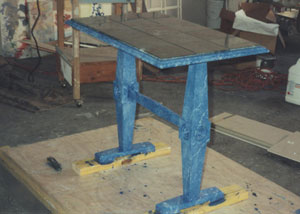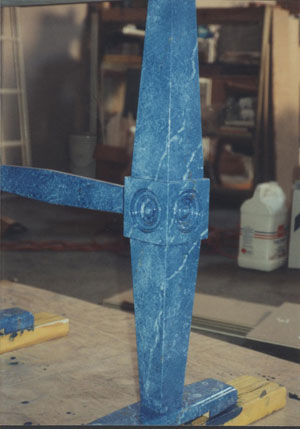When Glasstire approached me with the idea of writing about the worst piece of art I ever made, I knew immediately which one would qualify. This one painting stood out among the bad paintings I’ve made through That’s Painting Productions, a house-painting company I founded in 1989 and ran as an art project for the next twenty years. Working on commissions, I cannot easily choose what I make. I basically follow the client’s intentions, bringing my know-how and techniques to realize what they envision. And in the end, the client has the final say in what is produced, for better or for worse. (One of the advantages of working on commission is that I can avoid the responsibility, and blame the client for the result.)
In 1997, a River Oaks client on Looscan Lane asked me to paint the base of a side table in a faux lapis lazuli. As French poet Paul Valery once said, “Seeing is forgetting the name of the thing one sees.” But a bad trompe l’oeil makes a liar out of the poet. When you see the lapis lazuli table, you know by name that it is a table and that it cannot be made of the brittle blue stone. A true trompe l’oeil is a blatant effort to make the viewer not know what they are seeing: trompe l’oeil means literally ‘trick the eye,’ ‘deceive the eye,’ ‘confuse the eye.’ A trompe l’oeil makes sense when the achieved look matches the function of the object on which it is applied. A faux-marble top on a faux-bronze base, even if the actual table is made of wood and cast plaster as was done for another client, is totally plausible; the illusion fits the design.

However a faux lapis lazuli table defies all reason. The real stone, rare and expensive, is sometimes called heaven stone because of its beautiful blue. Even if it once adorned the ballroom walls of Catherine the Great of Russia, it is mostly used for carving in jewelry, mosaics and vases. In ancient Egypt, it was the stone of choice for amulets and ornaments (remember the scarabs of Art History classes?) probably because it was thought to have magical powers. And, as reported by Wikipedia, it is “the stone of friendship and truth” for the New Age generation. “The blue stone is said to encourage harmony in relationships and help its wearer to be authentic and give his or her opinion openly.”
But used as a table base? I couldn’t figure out the thinking behind the client’s decision to have a side table painted in faux lapis lazuli. Was it to go with the dark green marble-tiled top? The two colors clashed terribly. The marble tiles looked cheap, and so did the faux lapis, which is supposed to be one of the most expensive stones! To this day I am still wondering what the client was thinking when she commissioned such a painting. What kind of thoughts made her want to have a fairly common-looking table painted in faux lapis lazuli? Was it that the expensive stone would reflect on her social status? Was it that the whimsy of such a table -obviously a fake – would bring a smile on her face every time she looked at it?
These types of questions, even when left unanswered, constitute an integral part of my work, which started as an analysis of painting and gradually morphed into a service-providing activity. My inquiries into the inner working of painting started when I was in my first year of Painting at the Ecole des Beaux Arts in St. Etienne. I was just painting away, and I remember one day working on this still-life by a window in the studio: a dark green wicker chair set up in front of a small round table covered with a dark red velvety piece of fabric. As I was painting the scene, the red of the cloth peeking through the curved lines of the wicker chair kept popping out, on the canvas, in front of the green; when in reality, the fabric was behind the chair. I was having a hard time fighting to keep everything in its place. And all of a sudden, I understood the whole problem Matisse had grappled with in his work, as it came crashing on my canvas. Colors and forms can be perceived independently of what they might represent. I was struck by the planarity of the picture plane, and the futility of representation’s attempts to circumvent it. I realized that painting had its own way of operating, and I decided to keep trying to figure it out. It was not a “Damascus moment,” but more of an unspoken realization that there was something there very much worth digging into. And the more I dug, the more I found stuff to mine. And I’m still digging.
Since that day in St. Etienne, I have considered painting as a philosophical tool, rather than a means of expression. I was trying to figure out what is involved in the act of painting, trying to use paint in a way that does not represent anything, to paint without making images. Philosophy being a construction of concepts, I used painting to activate some of these concepts, rather than to illustrate ideas. And I came to the realization that house-painting was one form of painting that was totally outside of representation: a painted room is not a picture of the room, only a painting of it. So I started signing the houses and the rooms I painted, in order to make them part of my art work. This type of painting met all the criteria I had set for my work: paintings that were not pictures, paintings that did not result in images. But a client’s request to do a mural for her kitchen walls – birch trees with birds flying around them to echo the scene outside her window – forced me to reassess the situation. I realized that, in reality, I had become a service provider and that the activity had become more important than the end result. I did not have a personal vendetta against representation and it would have been silly to refuse to paint trees and birds, especially since I had all the training needed to do so.
Pretty soon this painting activity turned into a business, and my identity as an artist merged with that of an entrepreneur, integrating the two. I now had to deal with the responsibilities that come with both positions: aesthetic considerations and deontological situations: the accountability toward clients and my painting crew. Since the paintings produced resulted from commissions, the emphasis shifted from the aesthetic aspect of the work to its ontological status. Or as Stephen Wright would say, the “double ontological status” of a work which is at the same time art and house-painting; ontology being the branch of metaphysics dealing with the nature of being, reality, and existence.
For as long as there have been artists, their role in society has been tied to the position assigned to art in the culture of their society. At times like the Middle Ages and the Renaissance, when access to images was limited by their production and distribution, an artist’s role was to feed the collective imagination and to provide access to imaginary worlds. Today, as images have multiplied ad infinitum and virtual worlds are taking over our daily life, one of the artist’s roles might well be to offer a link to the real world, by providing the experience of a direct, unmediated relationship to reality. Once the viewer of one of the rooms or houses I painted becomes aware of the context in which it was done, their perception shifts and they start to pay attention to all forms of house painting. Saxophonist Richard Peck, who knows and appreciates my work, related to me an experience he had when on tour with the Philip Glass Ensemble in Montreal. Walking down the street, he saw through an open window a painting crew at work in a living room and stopped to watch for a while, totally present in the reality of the moment.
However, some in the art world and the public at large do not seem quite ready for this. A couple of years ago, an art writer reviewing a show of Rauschenberg’s cardboard pieces was ecstatic about the artist’s ability to “imbue humble material with remarkable beauty.” Rauschenberg’s cardboard pieces are not beautiful, they are just cardboard. When he put them up for display he was not trying to “imbue” them with any undying beauty, but to show us that we should not look only for beauty in art, and in things in general, but that we should first look at things for what they are. And a piece of cardboard is just that: a piece of cardboard. Rauschenberg, by his own saying, was trying to bridge the gap between art and life; he was not trying to aestheticize life and turn it into art. It is only because our prevailing culture is still trapped in this 19th century Romantic ideal of the nature of art that his gesture can be seen as an attempt to create beauty out of a piece of cardboard.
As Joseph Kosuth noted, “I began to realize that the intelligent and sensitive people in my environment had experiences with non-art portions of their visual world that were of such quality and consistency that the demarcation of similar experiences as art would make no appreciative difference.” Jan Tumlir, commenting on Kosuth’s remarks, wrote that “For art to cross that dividing line would mean its end as an autonomous concern.” (Artforum, Summer 2004, p. 236) The fact that one can think of such a possibility makes it already feasible; indeed, it is proof that it has happened already. Art is no longer an autonomous concern; I would argue that it has merged into reality.
![]()
Bernard Brunon was born in 1948 in St. Etienne, France. He holds a bachelor in Art History from the Université de Lyon and a Diplôme National des Beaux Arts in Painting from the Art School of Marseilles-Luminy. A Fulbright fellowship allowed him to come to Houston in 1978 and he graduated from the University of Houston’s
Art Department in 1981. In 2007, he became a grandfather and moved to
Los Angeles (these two events are not necessarily related). His latest
large project was a public commission to paint the façade of the University Library in Rennes, France.
![]()
Check out other artists’ Worst Art:
Benito Huerta:
The Worst Piece of Art I Ever Made: *OMG, IDNRTIHDSMWP!
Beth Secor: The Worst Piece of Art I Ever Made: Unicorns, Unicorns, Unicorns or How I Learned to Love the Bomb
Michael Bise: The Worst Piece of Art I Ever Made: The Black Box
Ludwig Schwarz: The Worst Piece of Art I Ever Made: Hot Dogs For All
Dolan Smith: The Worst Piece of Art I Ever Made: The Drawing that Doomed Dan Rather






2 comments
Great article Mr. Brunon, I especially appreciate the Paul Valery quote.
Enjoyable article, but I respectfully take issue with the following: “When you see the lapis lazuli table, you know by name that it is a table and that it cannot be made of the brittle blue stone.”
Wrong. YOU know this. Most people do not know that lapis is brittle.
“A true trompe l’oeil is a blatant effort to make the viewer not know what they are seeing: trompe l’oeil means literally ‘trick the eye,’ ‘deceive the eye,’ ‘confuse the eye.’”
Wrong again; I’ve seen Baroque era ceilings in churches and private homes with ceilings painted to depict balconies, clouds, the heavens, etc., with saints or Greco-Roman Gods peering down at the viewer. These paintings, by definition, are trompe l’oeil, but no one looking at them thinks that they are getting a glimpse into the abode of the Divine, or that the building they are in doesn’t have a roof.
It might have been better to have made your lapis table with PARTS of it painted to simulate that stone. I’ve seen (again) Baroque era gilt tables with real lapis tops, and the effect is wonderful. Still, your table has an element of fun and the whimsical to it. Don’t be so hard on yourself!